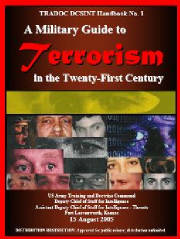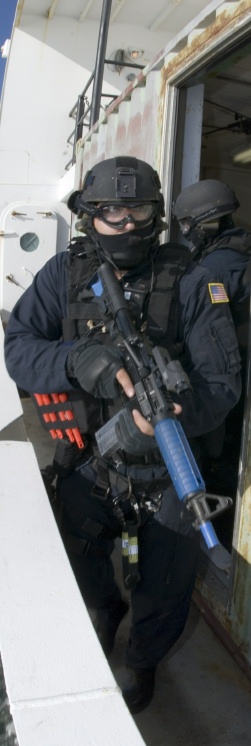|
SWAT Operational Guidelines and Standardized Training Recommendations -
Published by California POST - You can Download a copy
here:

|
| Click to Download |
In 1969,
Charles Sid Heal joined the United States Marine Corps. After serving a
combat tour in Vietnam, he returned home, joined the Marine Corps reserve and
attended college. Commander Charles Sid Heal began his law enforcement career
in 1975 as an investigator for the Los Angeles County District Attorneys
Office. In 1977, he joined the Los Angeles County Sheriffs Department as a
deputy sheriff. During his law enforcement career, he has worked various
assignments within the Los Angeles County Sheriffs Department, including Mens
Central Jail, Firestone Station and Industry Station.
Upon being
promoted to Sergeant in 1983, Commander Heal worked at Crescenta Valley Station
and the Special Enforcement Bureau. After being promoted to Lieutenant in 1989,
Commander Heal worked Central Property and Evidence, Firestone Station, Lennox
Station, Hall of Justice Jail, Transit Services Bureau, Walnut Station,
Emergency Operations Bureau, Special Projects Unit, and Field Operations Region
III Headquarters. In January 2000, he was promoted to Captain and selected to
command the Special Enforcement Bureau.
During his
35 years in the Marine Corps he has served in over 20 countries including
military operations in Vietnam, Desert Storm, Somalia and Iraqi Freedom.
Charles Sid Heal retired from the United States Marine Corps at the rank of
Chief Warrant Officer (CWO5).
Commander
Heal holds an Associate of Science Degree in Criminal Justice from Pasadena City
College, a Bachelor of Science Degree in Police Science and Administration from
California State University, Los Angeles, a Masters Degree in Public
Administration from the University of Southern California, and a Masters Degree
in Management from California Polytechnic University, Pomona. He is also a
graduate of the Federal Bureau of Investigations National Academy. Commander
Charles Sid Heal is the author of Sound Doctrine: A Tactical Primer
and An Illustrated Guide to Tactical Diagramming.
According
to the book description of Sound Doctrine: A Tactical Primer, In
recent years, law enforcement has suffered a number of tactical fiascoes.
Besides the loss of life and deterioration in public confidence, officers and
agencies have been the subject of both civil and criminal actions. Unlike most
tactical books, which reach tactics as a skill set, this book emphasizes an
intuitive application of fundamental principles. These principles have evolved
over the centuries of tactical operations and form a body of sound doctrine.
Colonel John B. Alexander, Ph.D. the author of Future War commented on
Sound Doctrine: A Tactical Primer, Required reading for all law
enforcement supervisors as well as those aspiring to enter their ranks. Steve
Ijames, Major, Springfield Missouri Police Department, remarked, A must read
for SWAT team members and commanders alike. It will cause many to rethink their
operational processes.
According
to the book description of An Illustrated Guide to Tactical Diagramming,
This book is not about construction, although you will learn about
building codes and practices. It is not about tactics, although the information
gained by knowing a floor plan will undoubtedly affect them. Instead, this book
is designed to provide a quick and simple method of confidently determining
floor plans by using outside architectural features. It assumes no knowledge of
construction or tactics and is designed to be useful whether it is read cover to
cover or occasionally referred to as a reference. It provides time-tested, tried
and true principles that any tactician can use to determine avenues of approach,
observation and fields of fire, obstacles, and cover or concealment, not to
mention where a suspect might be most vulnerable. Using this essential tool for
quick and clear comprehension of tactical diagramming, even a novice tactical
planner will learn to use windows, doors, vents and other clues to confidently
determine interior features. After reading this book, it will be clear that the
proverbial glass house is in the minds eye!

Vincent
Faggiano retired from the Rochester Police Department at the rank of captain. He
was responsible for the initial development of the BowMac Critical Incident
Response training programs, both for first responders and executive command post
managers. He has delivered these programs to thousands of law enforcement
officers, firefighters, emergency medical technicians, and elected officials in
the United States and abroad. He is the co-author of Critical Incident
Management. According to the book description, Critical Incident
Management, shows you how to respond effectively to any incident. The
book focuses on first responders and initial actions, the areas typically
overlooked by police agencies and the ones most criticized after the fact.
|
|
 |
|
Captain
John A. Kolman, Los Angeles County Sheriffs Department (ret.), is the founder
and first director of the National Tactical Officers Association. John A.
Kolman is the author of The Trials And Tribulations Of Becoming A Swat
Commander, Patrol Response to Contemporary Problems: Enhancing Performance of
First Responders Through Knowledge And Experience and Guide to the Development
of Special Weapons and Tactics Teams.
According
to Commander Sid Heal, The Trials And Tribulations Of Becoming A Swat
Commander, is clearly modeled after "Duffer's Drift" and fills a gap in
those texts that deal with essential material and the more interesting fiction
by combining an interesting scenario with an abundance of lessons learned.
Consequently, it should be considered a "must read" for law enforcement SWAT
personnel, but especially entry-level and first-line supervisors. The lessons
are durable, reliable and relevant for all domestic law enforcement but are
focused on that critical first-line supervisor. Especially poignant is the
overall theme that doing nothing to prepare yourself to handle these types of
situations is a recipe for disaster.
With 40 years of practice, and almost
25 years as a police officer James L. Greenstone, Ed.D., has expertise as a
police psychologist, a therapist, a teacher, an author, a police officer, a
mediator and negotiator, and as a consultant. The field of Crisis Intervention
has been his focus. For the better part of his career as a police officer, he
has worked extensively in the field of hostage and crisis negotiations. As a
mental health professional and consultant, and as a trainer of negotiators, as
well as a member of hostage negotiations teams, he is knowledgeable about
negotiator training, current practices in this area, dealing with suicidal and
barricaded subjects, negotiations techniques, team development, and team and
negotiator interactions with police tactical units. He has participated in
numerous hostage, barricaded and suicidal situations, and has practical
experience in all aspects of hostage and crisis negotiations team functioning.
Dr. James L. Greenstones book,
The Elements of Police Hostage and Crisis Negotiations, is designed for
day-to-day, on-the-scene use. It is a practical handbook for experienced
professionals and novices that can also be used as a supplementary textbook for
criminal justice, crisis intervention, and psychology coursework. Each chapter
contains useful checklists, procedural notes, tables, strategy worksheets, and
forms, and the book includes special indices for quick reference in addition to
a traditional index. The book examines the negotiation process from start to
finish, including pre-incident preparations, first response responsibilities,
responding to the call-out, arriving at the scene, preparing to negotiate,
making contact, preparing for the surrender, post-incident tasks, preparing
equipment, and more.
Ronald M.
McCarthy served as a Los Angeles police officer for over twenty-four. He was
assigned to the department's tactical unit, Metro Division, for 20 years and
retired from Special Weapons and Tactics as the senior supervisor and assistant
commander in 1984. Ronald McCarthy was the chief of Tactical Operations for the
U.S. Department of Energy from 1984 through 1986. He was the director of the
Deadly Force Training Grants for the U.S. Department of Justice and the
International Association of Chiefs of Police (IACP) from 1986 through 1988.
Ronald McCarthy served as manager for IACP's Center for Advanced Police Studies
from 1985 through 1992.
Since 1992,
Ronald McCarthy has been the owner of R.M. McCarthy & Associates, a training,
consulting, and marketing resource for law enforcement. He has trained police
officers from Europe, South America, the Middle East, and more than 30,000
police officers and military here in the United States.
Ronald
McCarthy was awarded the Los Angeles Police Department Medal of Valor for action
against the Symbionese Liberation Army in 1975, and the Police Star for the
rescue of hostages in 1983. He was presented with the National Tactical Officers
Association Award for Excellence in 1990. In 1995 the City of Erie, Pa.,
presented him with the All American Hero Award for his service to law
enforcement throughout the United States. In October of 1996, Ronald McCarthy
was awarded the National Tactical Officers Association's Lifetime Achievement
Award.
Ronald
McCarthy is the co-author of The Management of Police Specialized Tactical
Units. According to the book description, Managerial responsibility of
a SWAT team requires continuous research in the material area of long-term
criminal trends as well as keeping abreast of new developments in relevant
tactics, technology, and techniques of law enforcement and the legal issues
covering their use. The Management of Police Specialized Tactical Units explains
the steps for developing and maintaining a realistic, effective response to
increasing levels of violent crime. The book makes extensive use of actual field
examples such as the North Hollywood Bank of America Shootout, the Mogadishu
Airport Incident, the Springle Street Incident, and the confrontation between
police and the Symbionese Liberation Army. Chapter Six discusses the various
types and sources of equipment designed to give tactical units more effective
technological choices and includes examples of practical application, and the
advantages and disadvantages of use. It answers questions of law regarding when
and under what circumstances the equipment may be used. Chapter Ten focuses on
the partnership needed between law enforcement and the media. The importance of
cooperation is stressed to ensure safety of police officers, hostages, news
personnel, and bystanders during a hostage situation. Suggestions for
establishing trust and credibility are presented. The final chapter explores
tactical operations of the future when dealing with increasingly violent
encounters with juvenile offenders, the phenomenon of suicide-by-cop, and the
likelihood of terrorist use of weapons of mass destruction.
|
 |
|
|
|
